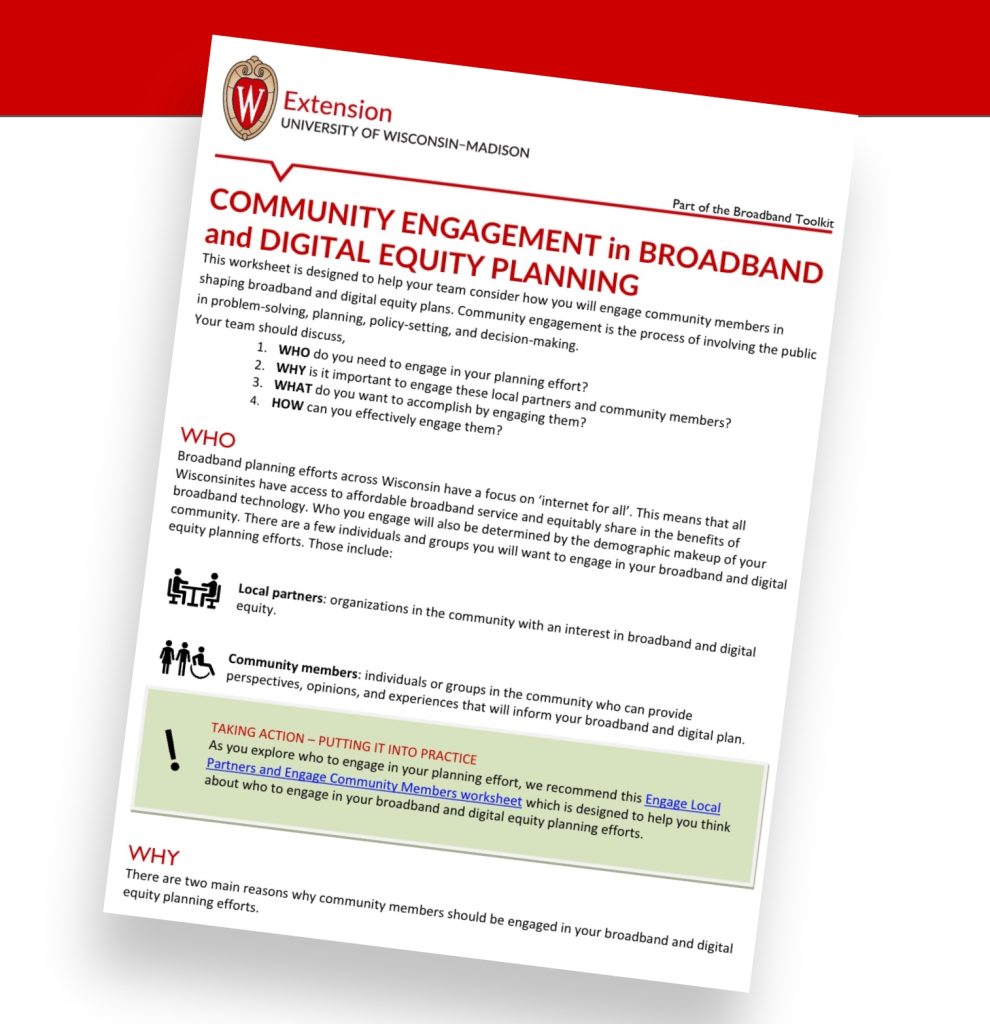Part of the Community Action Toolkit and the Broadband Toolkit
What is Community Engagement?
Community engagement is the process of involving the public in problem-solving, planning, policy-setting, and decision-making. This definition is grounded in the belief that everyone affected by a given decision has the right to participate in making it.
In this article, we will discuss the following questions:
- WHY engage the community?
- WHO to engage?
- WHAT do you want to accomplish through community engagement?
- HOW can you effectively engage the community?
Why?
Effective community change efforts follow key principles, including:
- Model shared leadership.
- Include perspectives, opinions, and experiences from community members and partners.
- Be intentional about engaging individuals most impacted by an issue.
- Use various data sources to inform decisions.
- Consider how issues in the community are interrelated.
- Build on the assets and strengths of the community.
- Actively seek equitable solutions.
There are two main reasons it is important to engage people in community change.
- Community engagement produces better results.
When community members come to the table, they bring their unique knowledge and expertise, they can articulate their needs, and they can offer solutions to those needs. Additionally, when we engage community members in change, we create buy-in that legitimizes solutions, plans, decisions, and policy. - Community engagement produces more engaged community members.
When community members are invited to engage, they become more educated about the community, how decisions are made, and how they can be part of shaping change. As a result, they become more civically engaged overall.
Who?
When thinking about who to engaged in community change, it is helpful to consider two broad categories.
- Local Partners
These are organizations that have an interest in the change you are working toward. For example, local governments, schools, business community, nonprofits, libraries, emergency services, and healthcare. They may offer specific insight and expertise, or they may have influence or resources that can contribute to proposed solutions. - Community Members
These are individuals or groups in the community who can provide perspectives, opinions, and experiences that will inform your change effort. It is important to include individuals who are most impacted by the issue so they can help shape the outcomes you hope to achieve.
What and How?
There are five purposes for engaging local partners and community members in your change effort. With each purpose, there are increasing levels of engagement.
- Awareness
- Education
- Input
- Interaction
- Partnership
Along with each purpose, you are making a promise to the partners and community members you engage. The table below shows each purpose, the promise being made, and examples of different engagement methods.

| AWARENESS | EDUCATION | INPUT | INTERACTION | PARTNERSHIP |
|---|---|---|---|---|
| Purpose: Make the community aware of your change effort. Promise: We will keep you informed. | Purpose: Provide the community with information to assist them in better understanding needs, concerns, solutions, and plans. Promise: We will try to help you understand. | Purpose: Obtain community feedback on needs, concerns, solutions, and plans. Promise: We will provide opportunities for your input and feedback on how your input influenced decisions. | Purpose: Work directly with the community to ensure their issues and concerns are consistently understood and considered. Promise: We will work with you to ensure your concerns are directly reflected in the alternatives, strategies, and plans; and provide feedback on how your input influenced decisions. | Purpose: Place decision-making responsibilities in the hands of the community. Promise: We will work to implement what you decide. |
| Methods: direct mail, news releases, mass media, social media, displays, and exhibits | Methods: public education meetings, websites, newsletters | Methods: open houses, public hearings, surveys, focus group | Methods: asset mapping, community forums, citizen advisory committee, visioning | Methods: citizen planning committee |
Your Community Engagement Plan
Now that you know the Why, Who, What, and How of engaging people in your community change effort, you can put together a simple plan. What the plan looks like is unique to each community. That said, there are a few guidelines to consider as you develop your community engagement plan:
1. Multiple ways to engage.
Community members should be given several opportunities and ways to engage. This allows them to engage in ways they find valuable, and at times and in places that work for them. For example, opportunities to engage might include a public survey at the local library or online. Then later, you might have a community forum at a local school.
2. Equitable access.
It is important to remove as many barriers to participation as possible. This could include making sure the location for an open house is wheelchair accessible, having an interpreter available during a focus group, holding meetings in the evenings or on weekends, and making surveys available at public locations such as schools and the library.
3. Communicate how input was used.
If you want people to continue to engage, it is important to let them know how you used the information, input, and feedback they provided. For example, after you compile the results of a public survey, you could create a press release that explains what your team learned from the survey and how that information will be used.
4. Celebrate milestones.
Part of engaging the community includes celebrating milestones. It is easy to overlook this important step, so make sure you consider how and when you want to celebrate. Celebrating milestones helps people see what is working, strengthens relationships and engagement, and creates positive momentum. For example, you could host a community celebration, inviting contributors, community members, and the press. During this event, you can share progress, gather additional input, and recognize people who have been part of the change process.
Putting it Into Practice

Community Engagement in Broadband and Digital Equity Planning: To access a summary of this article and an example of a broadband and digital equity community engagement plan, please download the worksheet.

 How and why we must improve civic health
How and why we must improve civic health Leading in times of change
Leading in times of change Goodbye icebreakers, hello improv!
Goodbye icebreakers, hello improv! The Power of Storytelling in Creating Pivotal Community Leadership
The Power of Storytelling in Creating Pivotal Community Leadership


